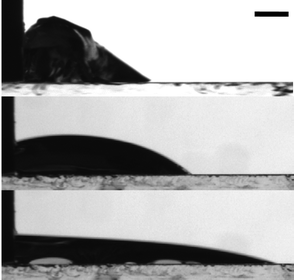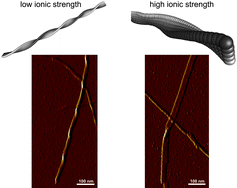 Rheology in eye wetting: Wetting phenomena in the tear film, the coating of the eye, was modelled with four insoluble surfactants, including meibum, a primary component of the lipid layer of the tear film, on a water droplet. The work suggests that surface rheology has a strong influence on the wetting phenomena. Danielle L. Leiske, Cécile Monteux, Michelle Senchyna, Howard A. Ketelson and Gerald G. Fuller, Soft Matter, 2011, Advance Article, DOI: 10.1039/C1SM05231D
Rheology in eye wetting: Wetting phenomena in the tear film, the coating of the eye, was modelled with four insoluble surfactants, including meibum, a primary component of the lipid layer of the tear film, on a water droplet. The work suggests that surface rheology has a strong influence on the wetting phenomena. Danielle L. Leiske, Cécile Monteux, Michelle Senchyna, Howard A. Ketelson and Gerald G. Fuller, Soft Matter, 2011, Advance Article, DOI: 10.1039/C1SM05231D
 External control of self-assembled nanoparticle size: Cyclodextrin was used as an external trigger to direct the size of self-assembled nanoparticles. The host molecule was added to polyadimoamine dendrimer and diazo dye nanoparticles to cause stepwise size increase of the particles. This allowed dynamic size control without the need for synthesis of specific building blocks, or direct inclusion of the cyclodextrin. Immanuel Willerich, Torben Schindler, Helmut Ritter and Franziska Gröhn, Soft Matter, 2011, Advance Article, DOI: 10.1039/C1SM05405H
External control of self-assembled nanoparticle size: Cyclodextrin was used as an external trigger to direct the size of self-assembled nanoparticles. The host molecule was added to polyadimoamine dendrimer and diazo dye nanoparticles to cause stepwise size increase of the particles. This allowed dynamic size control without the need for synthesis of specific building blocks, or direct inclusion of the cyclodextrin. Immanuel Willerich, Torben Schindler, Helmut Ritter and Franziska Gröhn, Soft Matter, 2011, Advance Article, DOI: 10.1039/C1SM05405H
 Amyloid protein pitch: New experimental and theoretical evidence demonstrates that periodic twisting pitch in protein amyloid fibrils arises from the competing electrostatic and torsional elastic energies stored along the fibrils contour length. Amyloid fibrils are highly important in processes such as Alheimer’s and Parkinson’s disease. Jozef Adamcik and Raffaele Mezzenga , Soft Matter, 2011, Advance Article, DOI: 10.1039/C1SM05382E
Amyloid protein pitch: New experimental and theoretical evidence demonstrates that periodic twisting pitch in protein amyloid fibrils arises from the competing electrostatic and torsional elastic energies stored along the fibrils contour length. Amyloid fibrils are highly important in processes such as Alheimer’s and Parkinson’s disease. Jozef Adamcik and Raffaele Mezzenga , Soft Matter, 2011, Advance Article, DOI: 10.1039/C1SM05382E
Read all for free until June 17.










